
The University’s School of Health Sciences has been awarded £50k from the Office for Students to fund a unique project aiming to reduce clinical training burden through integrated simulation placements.
Students within the School spend a substantial amount of their courses learning out in clinical departments and this can prove challenging in logistical terms for both departments and students.
Placement weeks undertaken in a ‘simulated clinical environment’ on campus could help to reduce this requirement and improve the student experience while reducing the strain on busy clinical departments.
The ‘Strategic Interventions in Health Education Disciplines (SIHED) funding was awarded to a team drawn from all the Allied Health disciplines within the School.
The project builds on a previous successful pilot developed with funding from the first round of the SIHED challenge fund, which demonstrated student attainment of clinical outcomes following a simulated placement.
As part of the project The Radiotherapy Team at the University has just taken delivery of the new Virtual Environment for Radiotherapy (VERT) proton simulation module. This world first software has been generously provided by VERTUAL as part of their support for this innovative research project.
Dr Pete Bridge, Senior Radiotherapy Lecturer, said: “This world-first quantitative evaluation showed that integrated simulated placement weeks are capable of facilitating student clinical training. This finding also suggested that overall clinical placement weeks could be reduced through effective deployment of simulated placements.
“This second project aims to identify the wider role of campus-based simulations in allied health student training by evaluating student feedback on simulated placements across a range of health professions. This will then be followed by a large-scale Delphi study to gather consensus data regarding the optimal role of simulated placements in allied health student training. This in turn will help ensure that optimal use is made of clinical placement time and increase efficiency and effectiveness of these rich learning opportunities.
“The project will allow students within the School of Health Sciences to make use of the outstanding simulation facilities within the School including both virtual reality (VR) and equipment-based resources. The integrated simulation placement will also draw on the School’s strong links to the local community with service users and actors providing challenging scenarios and realistic experiences for the students.”
For more information please visit the Office for Students’ ‘I see the Difference’ site which features an interview about the project with a University of Liverpool Radiography student.